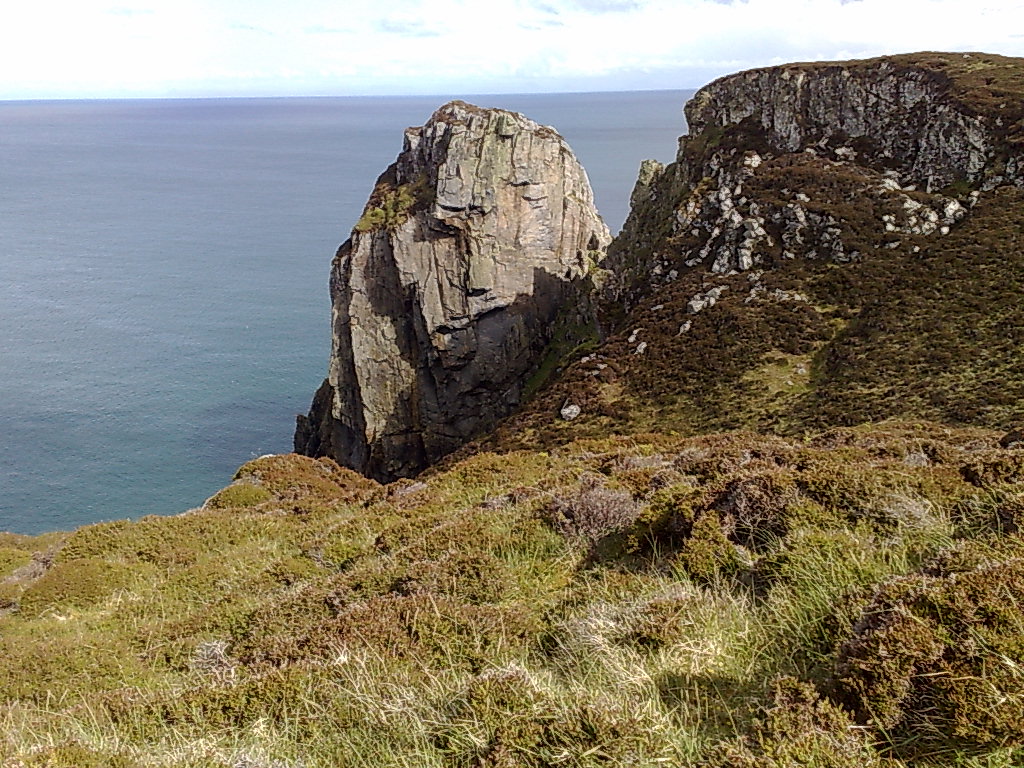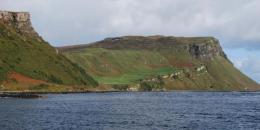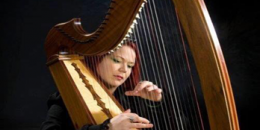TRADITIONS IN ASSYNT AND THE LEWS
Of the ancient races of the West and North which have been dignified with the title of the Great Clans, only one may be said to have fallen entirely to pieces in the course of time. The fact speaks volumes for the vitality of these warrior tribes, and the healthiness of the seemingly hard conditions amid which they lived and struggled. The conclusions of Skene in his Highlanders of Scotland have not always been approved by later writers, but it is worth noting that he identifies Clan Nicol with the Kairinoi of the early geographer Ptolemy. Skene identifies the Ness district of the Norwegian sagas with the region in the north-west of Scotland now known as Edyrachillis, Duirinish, and Assynt, and he declares that "the most ancient Gaelic clan which can be traced as inhabiting these districts is the clan Nicail or Macnicol’s."
In the article on “Assynt "in the Statistical Account of Scotland, the Rev. William Mackenzie records that "Tradition and even documents declare that it was a forest of the ancient Thanes of Sutherland. One of these Prince Thanes gave it in vassalage to one Macrycul, who in ancient times held the coast of Coygeach, that part of it at the place presently called Ullapool. The noble Thane made Assynt over in the above manner, as Mackrycul had recovered a great quantity of cattle carried off from the county of Sutherland by foreign invaders. "Mackenzie adds in a note, Mackrycul is reputed by the people here to be the potent man of who are descended the Macnicol’s, Nichol’s, and Nicolson’s."
According to the Gaelic genealogical manuscript of 1467, known earlier as MS1450, on which Skene founds so much of his writing regarding the clans, this account is probably correct, for in that manuscript the descent of the Clan Nicail is traced in a direct line from a certain Gregall, who is obviously the Krycul of the tradition. Further, as the letters r and n are interchangeable in Gaelic, it can easily be seen how Macrycul became MacNicail or MacNicol, of which the English translation is of course Nicolson. The recovery of the great herd of Sutherland cattle from Norwegian invaders is believed to have been accomplished by Macrycul or MacNicol of Coygeach some time in the twelfth century. To accomplish such a feat he must have been at the head of a considerable army or clan, so the probability is that the race of Krycul or Gregall had been chiefs at Ullapool for a long period before that. This would take their ancestry back to the days of Malcolm Canmore at least.
Gaelic Manuscript 1467 (MS1467), known earlier as MS1450 | ||||
|
| |||
About the time of the battle of Bannockburn the line of the MacNicol chiefs ended in an heiress who married Torquil, a younger son of MacLeod of the Lewis, and the pair obtained a Crown charter of the lands of Assynt and others which had been the MacNicol property. From this marriage descended fourteen successive MacLeod lairds of Assynt. It was one of these MacLeods of Assynt who in 1650 earned the execration of the Highlanders by handing over the Great Marques of Montrose to the Covenanting Government at whose head was his implacable enemy, the crafty Marques of Argyll. MacLeod was then in money difficulties, which perhaps explained his willingness to earn the Government reward. Ten years later his chief creditor, the Earl of Seaforth, foreclosed his wadsets and took possession of the Assynt estates. Still later Assynt was purchased by the Sutherland family. The more northern part of the old MacNicol country remained in other hands till MacLeod of Edyrachillis and Morison of Duirinish took occasion to engage in a feud, whereupon their neighbors the MacKays, then at the height of their power, stepped in and wrested these estates from both families, and from that time Edyrachillis and Duirinish became parts of the Lord Reay’s country.
Meanwhile, on the death of the last MacNicol of Coygeach, Assynt, Edyrachillis, and Duirinish, the chiefship of the clan had by patriarchal law, passed to the nearest male of the race, and the seat of this line was afterwards removed to Scoirebreac, a beautiful spot on the coast of Skye near Portree. Here they appear to have shown their piety, prevision, or ostentation by benefactions to the religious house, of which the ruins may yet be seen on an island at the head of Loch Snizort. A small chapel on the south side of the main buildings is still known as Macnicol’s Aisle, and within it is to be seen the effigy of a warrior in conical helmet and long quilted coat or habergeon, who must have been a man of much power in his time.
THE MACNICOLS AND EDWARD THE BRUCE
According to Sellar, possibly one of the earliest references to a Clan MacNeacail chief appears in a passage from John Barbour's epic The Bruce, which dates to about 1375. Sellar believes that the Maknakill recorded may be the chief, or at least a close relative to the chief of Clan MacNeacail. The passage below recounts the siege of Carrickfergus Castle in April 1316, by Edward Bruce, brother of Robert I.
For to ye fycht Maknakill yen Com with twa hundreth sper-men And yai slew all yai mycht to-wyn Yis ilk Maknakill with a gyn Wan off yar schippis four or fyve And haly reft ye men yar lif. - John Barbour, The Bruce | MacNicol came then to the fight |
During Bruce's siege, Sir Thomas Mandeville arrived in Dublin with 15 ships in an attempt to lift the siege. Sellar argued that the arrival of Maknakill would have played a large part in preventing Mandeville from relieving the castle. Sellar is of the opinion that the "Maknakill" recorded in The Bruce may be the same as the "mak Nakyl" and "macnakild" recorded in 1306 and 1315. In 1306, letters were delivered from Edward I of England to the Earl of Ross, Lachlan MacRuairi, his brother Ruairi, and John “Mak Nakyl". In 1315, Edward II of England instructed John MacDougall of Argyll to receive Donald MacDonald, his brother Godfrey, Sir Patrick Graham and John "macnakild" into the king's peace. According to Sellar, since the MacDougalls, MacDonalds and MacRuairis mentioned were all prominent Hebridean leaders it is quite likely the “Mak Nakyl" and “Macnakild" was also a Hebridean leader.
A DESCRIPTION OF THE LEWS
In the late 17th century the origin of the Macaulays, Macleods, MacNeacails, and Morrisons was documented in an historical account of Lewis. John Morisone, self-described "Indweller" of Lewis, writing sometime between about 1678 and 1688, stated that the early inhabitants of Lewis were three men from three separate races.
The first and most antient Inhabitants of this Countrie were three men of three severall races viz. Mores the son of Kenannus whom the Irish historiance call Makurich whom they make to be Naturall Sone to one of the Kings of Noruvay, some of whose posteritie remains in the land to this day. All Morisones in Scotland may challenge there descent from this man. The second was Iskair Mac.Awlay ane Irish man whose posteritie remain likvise to this day in the Lews. The third was Macknaicle whose onlie daughter Torquill the first of that name (and sone to Claudius the sone of Olipheous, who likewise is said to be the King of Noruway his sone,) did violentlie espouse, and cutt off Immediatlie the whole race of Macknaicle and possessed himself with the whole Lews and continueth to his posteritie (Macleud of Lews) dureing 13 or 14 generations and so extinct before, or at least about the year 1600 the maner of his decay I omitt because I intend no historie but a descriptione. — John Morisone, A Descriptione of the Lews. |
OTHER TRADITIONS CONCERING THE CLAN - ON THE ISLE OF LEWIS
On Lewis the ravine separating Dùn Othail from the mainland is called "Leum Mhac Nicol", which translates from Scottish Gaelic as "Nicolson's Leap". Legend was that a MacNeacail, for a certain crime, was sentenced by the chief of Lewis to be castrated. In revenge he ran off with the chief's only child to the ravine and leaped across the chasm. MacNeacail threatened to throw the child into the sea unless the chief himself agreed to be mutilated as well. Attempts at rescuing the child failed and the chief finally agreed to the mans terms. Just as the chief consented MacNeacail leaped over the cliff and into the sea with the child crying out in Gaelic. "I shall have no heir, and he shall have no heir".
Nicolson's Leap |
|
OTHER TRADITIONS CONCERING THE CLAN - ON THE ISLE OF SKYE
A tradition from Skye is that a chief of the MacNicol Clan, MacNicol Mor, was engaged in a heated discussion with Macleod of Raasay. As the two argued in English a servant, who could speak only Gaelic, imagined that the two leaders were quarrelling. The servant, thinking his master in danger, then drew his sword and slew MacNicol Mor. To prevent a feud between the two clans, the clan elders and chiefs then held council to decide how to appease the MacNicols. The decision agreed upon was that the "meanest" of Clan Nicol would behead Macleod of Raasay. Lomach, a lowly maker of pannier baskets, was chosen and accordingly cut off the head of the Laird of Raasay.
Stories of the MacNicols of Scorrybreac come down to the beginning of the nineteenth century. About that time, according to the author of the letterpress in M’Ian’s Clans of the Scottish Highlands, at a banquet of the clansmen given to celebrate some joyful occasion, there was a call for the bards to come to the upper end of the room. Convinced of the hopelessness of the summons MacNicol of Scorrybreac exclaimed, "The bards are extinct! " He was promptly taken to task by one of the company, Alastair bui’ Mac Ivor, who retorted, "No, they are not extinct, but those who delighted to patronize them are gone."
While the seat of the MacNicol chiefs was in Skye there were many of the name scattered throughout the county of Argyll, and of these there were several individuals whose characteristics or exploits have been perpetuated in tradition. One of them, reputed to be a seer, obtained the name of Gualan Crostadh from his rule never to look behind him. For the same reason he was also known as "an Teallsanach" or the Philosopher. As might be expected of such a personage, a crop of stories was long extant regarding him. Another of the clan, Gillespie MacNicol, attained fame by a rescue he affected at somewhat serious cost to himself. After the last Jacobite raising a widow’s son had fallen into the hands of the "red soldiers," as Government troops were called, and they were carrying him off, when the redoubtable Gillespie came to the rescue. Attacking the soldiers, be slew one or two, put the others to flight, and set the captive free. Unluckily, as he did so, he received a sword stroke in the face which carried off his nose.
Among members of the clan who have attained more than local repute was the Rev. Donald MacNicol, whose best known work was his defense of the Highlands against the accusations made by Dr. Samuel Johnson in his Journey to the Hebrides. Of the same period also were the Rev. Francis Nicoll, D.D., Principal of St. Leonard’s and St. Salvatore’s Colleges, St. Andrews, and Robert Nicoll, the poet who became editor of the Leeds Times in 1836. Still later were the Nichols, father and son, professors, one of astronomy and the other of English literature at Glasgow University. There was also Alexander Nicolson, the Gaelic scholar who died Sheriff-Substitute of Greenock in 1893. He is chiefly remembered by his revision of the Gaelic Bible and his collection of Gaelic proverbs. One of the ablest journalists of recent times, too, was Sir William Robertson Nicol, founder of The British Weekly and "discoverer” of Sir J. M. Barrie and other well-known writers.










